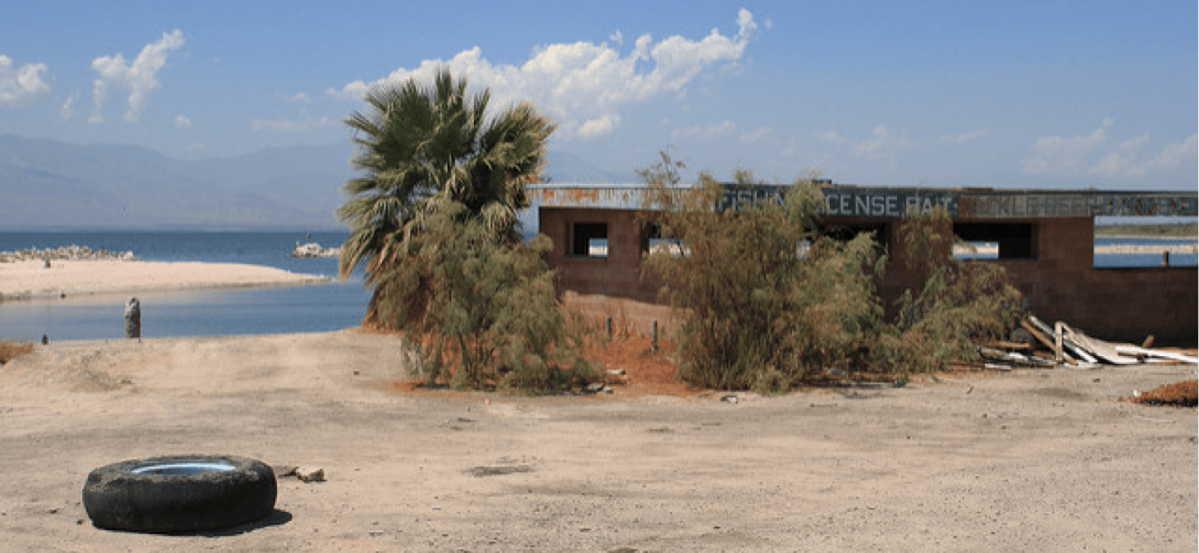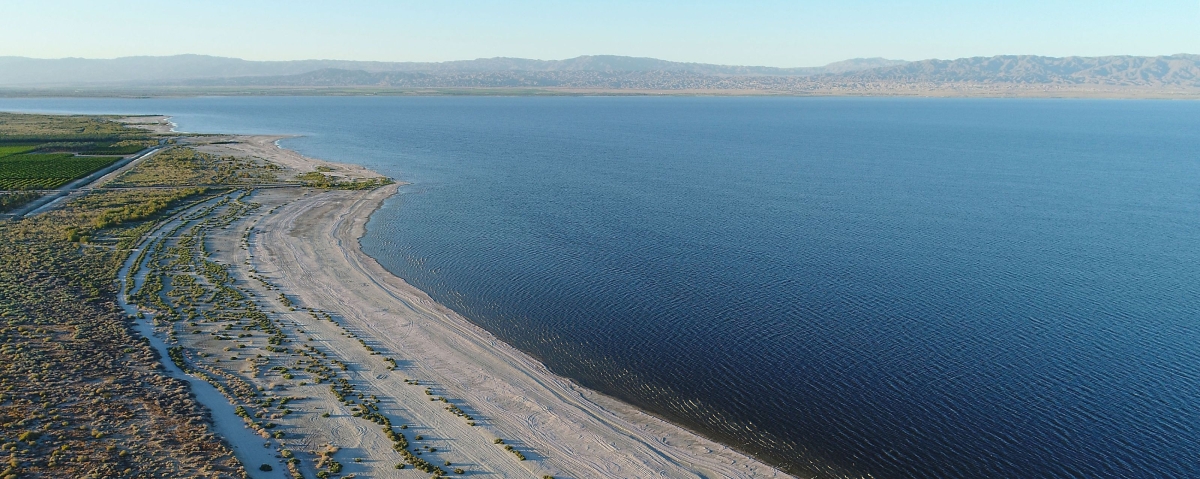The Salton Sea is California’s largest body of water and is disappearing at an accelerated rate due to climate change, drought, and reduced agricultural runoffs. The Salton Sea is technically a lake; as the lake evaporates and shrinks, its dry lakebed containing toxic arsenic, selenium, chromium, lead, and pesticides from the nearby farms, becomes exposed. Scientists warn that chemicals trapped in the lakebed deposits can be picked up by winds, spreading toxic dust particles throughout the atmosphere in Imperial and Coachella Counties. A recent study led by graduate student Alexander Frie and Dr. Roya Bahreini, PhD from the University of California, Riverside has already found high concentrations of sodium and selenium in airborne particulate matter surrounding the sea and traced about 10% of particulate matter back to lakebed dust. As the shoreline shrinks, more lakebed is exposed, generating heavier dust emissions. These emissions contribute to greater airborne pollution, worsening air quality.
 An expanding lake bed. Photo credit: Devon Christopher Adams
An expanding lake bed. Photo credit: Devon Christopher Adams
Airborne particulate pollution and poor air quality are linked to a number of respiratory diseases. Public health officials are concerned that dust emissions from the shrinking Salton Sea are threatening the health of the predominantly Latino population that live nearby. Imperial County experiences hazardous air quality conditions—and a shrinking Salton Sea will only make air pollution matters worse. Around 23,000 Imperial County residents, including children, are currently diagnosed with asthma. In fact, Imperial County experiences the highest number of pediatric asthma-related emergency room visits in the entire State of California. While it is tough to directly attribute the cause of this rampant asthma to the increasingly exposed lakebed and increased dust emissions resulting from it, research outcomes reveal robust links between airborne particulate pollution and the development of asthma in childhood.
 Salton Sea lakebed. Photo credit: Kevin Key
Salton Sea lakebed. Photo credit: Kevin Key
Unfortunately, the potential public health costs of a receding Salton Sea shoreline extend far beyond respiratory health problems. A number of research studies have linked pediatric asthma to childhood anxiety and mood disorders. High concentrations of airborne particulate pollution can indirectly pose a mental health threat, too. One study in Pakistan of low income children found that children with asthma are 18 times more likely to have mental health problems than those without asthma, even after considering differences that might exist among the children, like their age, sex, household size, birth weight, allergies, and whether they had a family history of asthma. Another study from Australia, tracking children over several years, found that a diagnosis of severe and persistent asthma at 5 years of age was linked to a significantly greater risk for developing anxiety and other mental health problems in early adolescence. Having poorly managed asthma makes it more likely a child will develop mental health problems; and the worse the air quality, the harder it is to manage asthma.
 Dead fish at the Salton Sea. Photo credit: Devon Christopher Adams
Dead fish at the Salton Sea. Photo credit: Devon Christopher Adams
Public health officials in Imperial County could promote programs that can target the respiratory and mental health problems that a shrinking Salton Sea may be amplifying. Heightened stress levels among families with asthmatic children have been shown to exacerbate both asthma and anxiety symptoms. A study in California found that high parental stress and low socio-economic status were both linked to increased risk for asthma among families exposed to high concentrations of airborne particulate pollution. Unfortunately, close to a quarter of the population in Imperial and Coachella counties are currently living in poverty, which not only increases familial stress levels but also reduces access to therapy and other comprehensive mental and physical healthcare services. For lower income families, affordable, easy-to-implement stress management practices could impact both asthma and anxiety development and symptoms.
 Dust skies at the Salton Sea. Photo credit: Kevin Key
Dust skies at the Salton Sea. Photo credit: Kevin Key
Education programs that teach families about the importance of stress management for disease care and provide useful, feasible stress management strategies that cater to Imperial County residents may generate numerous benefits. In order for community-based stress management programs to be effective though, they should consider that environmental, financial, and physical health-related constraints may render many common strategies impractical. For example, preventative measures like spending time outdoors or in nature, engaging in physical exercise and receiving sun exposure to stimulate vitamin D production are cost-effective but potentially counterproductive when air quality problems mean that it is safer for families to stay indoors. Furthermore, several of the free, indoor preventative strategies such as yoga, using breathing-focused relaxation techniques, and practicing good sleep hygiene may be especially difficult for individuals with poorly-managed or severe asthma that have trouble breathing. Minimal knowledge of stress management options that are affordable, safe and practical for families with asthmatic children may increase the mental and physical health risks among Imperial County community members.
 A dust storm at the Salton Sea. Photo credit: Kevin Key
A dust storm at the Salton Sea. Photo credit: Kevin Key
A comprehensive plan to mitigate the public health risks faced by Imperial County residents requires urgent attention not only to the worsening air quality but also to familial stress management practices. Public health education campaigns could teach low-cost, easy-to-implement stress management techniques, specifically for families with asthma sufferers living in regions with hazardous air quality conditions. Educating families about the health risks the lake may pose could foster collaborative efforts among residents, community organizations, and policy makers to work together on sea management solutions that consider its broader public health consequences. The type of education campaign needed is not easily created, but is increasingly necessary. As the Sea recedes at a rapid pace, families and children are placed at cumulative risk for simultaneously developing multiple illnesses, spanning physical and mental health. With a quarter of the regional population living in poverty, the local community cannot afford to shoulder the accumulating health care costs that can be linked back, directly or indirectly, to the Salton Sea. A broad-gauged approach is needed that not only directly addresses the shrinking sea but also considers the livelihood and position of families in the surrounding community.
Parisa is a fourth-year doctoral student in Developmental Psychology and an interdisciplinary NSF WaterSENSE IGERT Fellow at the University of California, Riverside. Her work uses eye-tracking, behavioral, and physiological measures to understand cognitive and emotional-regulatory processes related to how people (children and adults) manage negative emotional situations.














